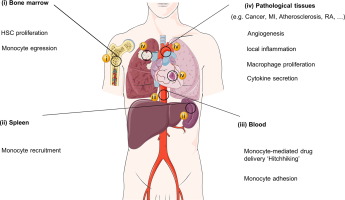Advanced Drug Delivery Reviews ( IF 15.2 ) Pub Date : 2017-05-12 , DOI: 10.1016/j.addr.2017.05.009 Amr Alaarg 1 , Carlos Pérez-Medina 2 , Josbert M Metselaar 3 , Matthias Nahrendorf 4 , Zahi A Fayad 2 , Gert Storm 5 , Willem J M Mulder 6

|
Inflammation and angiogenesis drive the development and progression of multiple devastating diseases such as atherosclerosis, cancer, rheumatoid arthritis, and inflammatory bowel disease. Though these diseases have very different phenotypic consequences, they possess several common pathophysiological features in which monocyte recruitment, macrophage polarization, and enhanced vascular permeability play critical roles. Thus, developing rational targeting strategies tailored to the different stages of the journey of monocytes, from bone marrow to local lesions, and their extravasation from the vasculature in diseased tissues will advance nanomedicine. The integration of in vivo imaging uniquely allows studying nanoparticle kinetics, accumulation, clearance, and biological activity, at levels ranging from subcellular to an entire organism, and will shed light on the fate of intravenously administered nanomedicines. We anticipate that convergence of nanomedicines, biomedical engineering, and life sciences will help to advance clinically relevant therapeutics and diagnostic agents for patients with chronic inflammatory diseases.
中文翻译:

纳米医学在适应不良炎症和血管生成中的应用
炎症和血管生成驱动多种破坏性疾病的发生和进展,例如动脉粥样硬化、癌症、类风湿性关节炎和炎症性肠病。尽管这些疾病具有截然不同的表型后果,但它们具有几种常见的病理生理学特征,其中单核细胞募集、巨噬细胞极化和血管通透性增强发挥着关键作用。因此,针对单核细胞旅程的不同阶段(从骨髓到局部病变,以及它们从患病组织的脉管系统中外渗)制定合理的靶向策略将推动纳米医学的发展。体内成像的集成独特地允许在从亚细胞到整个生物体的水平上研究纳米颗粒动力学、积累、清除和生物活性,并将揭示静脉注射纳米药物的命运。我们预计纳米医学、生物医学工程和生命科学的融合将有助于推进慢性炎症性疾病患者的临床相关治疗和诊断药物。











































 京公网安备 11010802027423号
京公网安备 11010802027423号